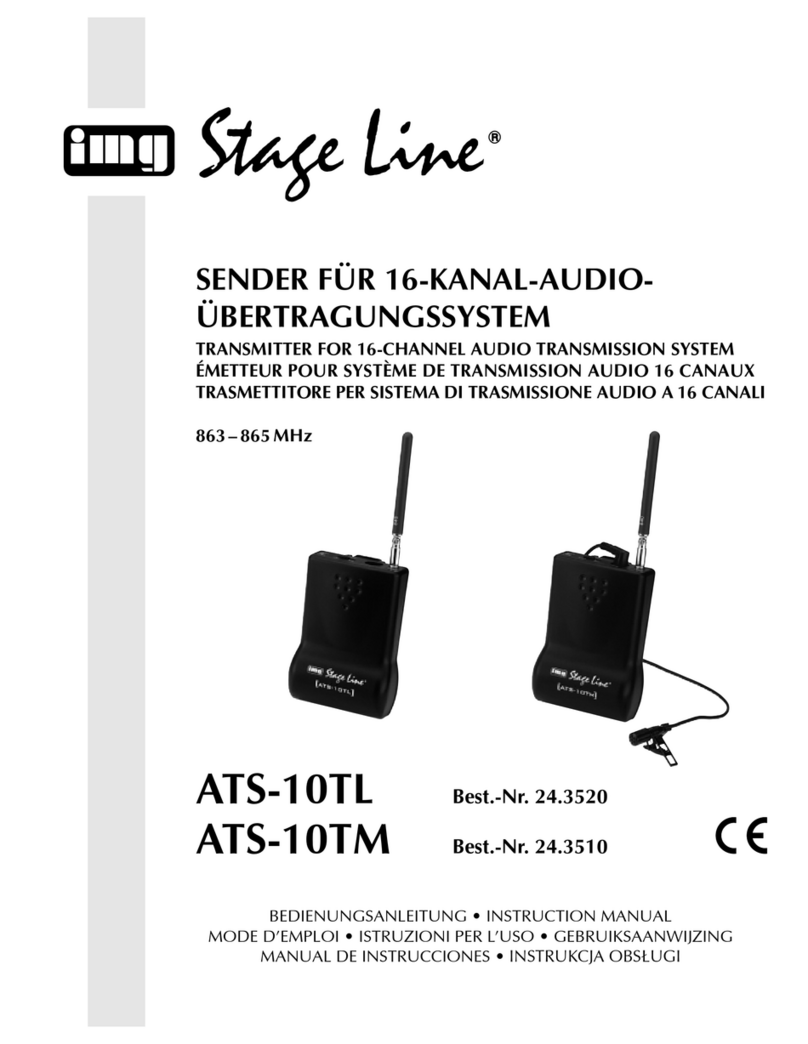7) Den Sender mit der rückseitigen Gürtelklemme
an der Kleidung befestigen.
8) Zum Ausschalten des Senders den Ein-/Aus-
schalter (2) in die Position OFF („aus“) schwen-
ken. Im Display wird eingeblendet, danach
schaltet sich der Sender aus.
5.1 Sender einstellen
Bei nicht gesperrtem Sender lassen sich die Ein-
stellmodi nacheinander mit der Taste SET (4) auf-
rufen:
Gruppe (Taste länger drücken) →Kanal
→Empfindlichkeit →Sendeleistung
→Automatische Frequenzabstimmung
→Identifikationsnummer →Sperrfunktion
Um Einstellungen in einem Einstellmodus durchzu-
führen, siehe das entsprechende Kapitel 5.1.1 bis
5.1.6.
Soll ein Einstellmodus ohne Änderung wieder
verlassen werden, die Taste SET so oft drücken,
bis im Display kurz (= widerrufen) erscheint.
Das Gerät wechselt dann zurück in den Normal-
betrieb.
5.1.1 Übertragungsfrequenz (Gruppe/Kanal)
Um den Sender schnell und unkompliziert auf die
Übertragungsfrequenz der Empfangseinheit einzu-
stellen, kann die REMOSET-Funktion genutzt wer-
den (Kapitel 5, Bedienschritt 4). Die Übertra-
gungsfrequenz des Senders lässt sich aber auch
manuell über die Wahl der Kanalgruppe und des
Kanals einstellen. In der Tabelle auf Seite 20 finden
Sie eine Übersicht der Gruppen und Kanäle.
1) Die Taste SET (4) so lange gedrückt halten, bis
das Display kurz anzeigt. Anschließend
blinkt die Gruppenanzeige ( ... ), der Grup-
peneinstellmodus ist aktiviert.
2) Die Gruppe mit der Abwärtstaste –(5) oder der
Aufwärtstaste +(6) auswählen.
3) Mit der Taste SET die Wahl bestätigen. Im Dis-
play blinkt die Kanalanzeige, der Kanaleinstell-
modus ist aktiviert.
4) Den Kanal mit der Abwärtstaste –oder der Auf-
wärtstaste +auswählen.
5) Mit der Taste SET die Wahl bestätigen. Im Dis-
play erscheint kurz (= speichern) und das
Gerät wechselt in den Normalbetrieb.
5.1.2 Empfindlichkeit
Die Empfindlichkeit kann in mehreren Stufen ein-
gestellt werden: von 12 dB (max. Empfindlichkeit)
bis
-
18 dB (min. Empfindlichkeit).
1) Die Taste SET (4) so lange gedrückt halten, bis
das Display kurz und dann den Gruppen-
einstellmodus (Gruppenanzeige blinkt) anzeigt.
2) Die Taste SET so oft drücken, bis das Display
kurz und danach die aktuell eingestellte
Empfindlichkeit anzeigt.
3) Die Empfindlichkeit so einstellen, dass ein opti-
maler Lautstärkepegel des Mikrofons erreicht
wird: Bei zu hoher Lautstärke verzerrt das Mikro-
fon, dann mit der Taste –(5) einen niedrigeren
Wert einstellen. Bei zu geringer Lautstärke ergibt
sich ein schlechter Rauschabstand, dann mit der
Taste +(6) einen höheren Wert einstellen.
4) Mit der Taste SET die Wahl bestätigen. Im Dis-
play erscheint kurz und das Gerät wech-
selt in den Normalbetrieb.
5.1.3 Sendeleistung
Es kann zwischen zwei Sendeleistungen gewählt
werden. Bei höherer Sendeleistung erhöht sich die
Reichweite, allerdings verkürzt sich auch die Be-
triebsdauer der Batterien, da diese schneller entla-
den werden.
1) Die Taste SET (4) so lange gedrückt halten, bis
das Display kurz und dann den Gruppen-
einstellmodus (Gruppenanzeige blinkt) anzeigt.
2) Die Taste SET so oft drücken, bis das Display
die aktuell eingestellte Sendeleistung anzeigt:
niedrigere Sendeleistung (10 mW)
höhere Sendeleistung (50 mW)
3) Mit der Taste –(5) die Einstellung wählen
oder mit der Taste +(6) die Einstellung .
4) Mit der Taste SET die Wahl bestätigen. Im Dis-
play erscheint kurz und das Gerät wech-
selt in den Normalbetrieb.
5.1.4 Automatische Frequenzabstimmung
(REMOSET-Funktion)
Für den Sender kann die automatische Frequenz-
abstimmung (REMOSET-Funktion = Frequenz-
einstellung des Senders durch ein Funksignal der
Empfangseinheit) zugelassen werden oder nicht.
1) Die Taste SET (4) so lange gedrückt halten, bis
das Display kurz und dann den Gruppen-
einstellmodus (Gruppenanzeige blinkt) anzeigt.
2) Die Taste SET so oft drücken, bis das Display
die aktuelle Einstellung zur automatischen Fre-
quenzabstimmung anzeigt:
automatische Frequenzabstimmung ist
zugelassen (d. h. die Frequenzeinstel-
lung des Senders über die REMOSET-
Funktion ist möglich)
6
D
A
CH





























